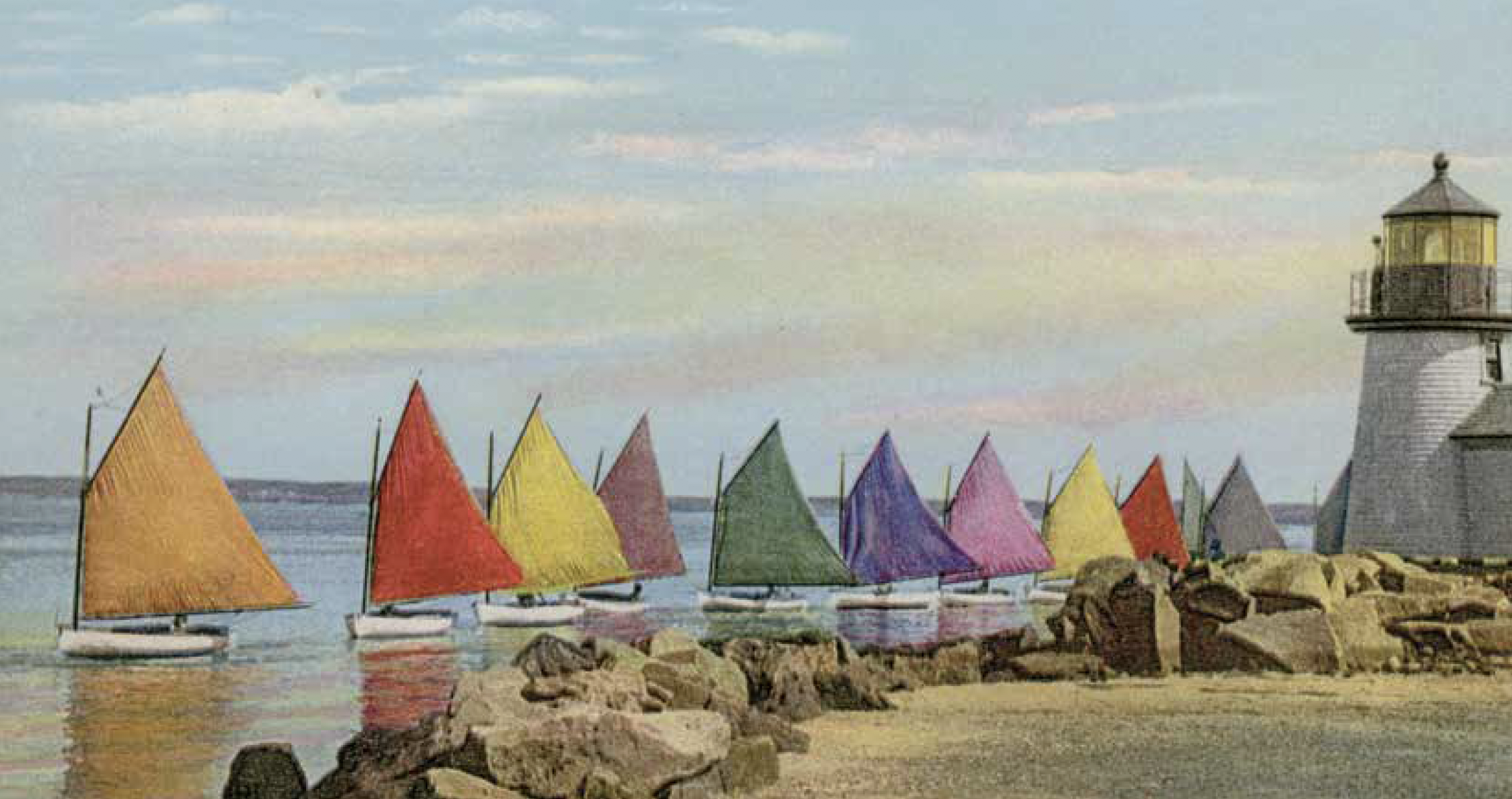Thank you to the Nantucket Historical Association and Michael R. Harrison for this fascinating blog on the Rainbow Fleet of Nantucket. Follow this link to read the complete article in the Fall 2018 issue of Historic Nantucket. Join the NHA as a member to receive this quarterly publication in the mail!
THE ORIGINS OF THE RAINBOW FLEET
By Michael R. Harrison, Obed Macy Director of Research & Collections
Every August, as part of Nantucket Race Week, the little catboats of the island’s beloved Rainbow Fleet raise their colorful sails and parade around Brant Point, weather permitting. This island tradition dates to the 1920s, and grew out of efforts by the leaders of the Nantucket Yacht Club to find a suitable boat for children and teenagers to learn to sail in.
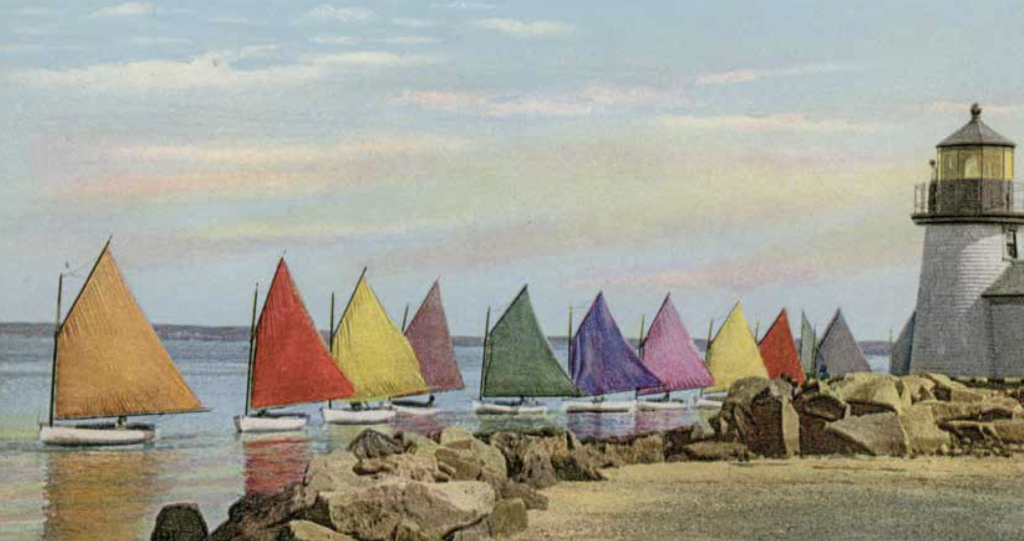
NHA COLLECTIONS PC BrantPoint 47
Originally, a catboat was any boat with a “cat rig,” that is, a single mast well forward supporting a single gaff-headed sail. Over time, this rig became associated with beamy, shoal-bottomed centerboard boats designed to operate in the windy, choppy, and shallow waters of such places as Lower New York Bay, Massachusetts Bay, and Nantucket Sound. The catboat is, historically, the quintessential Nantucket boat after the whaleboat. Although not exclusive to the island, the catboat was the dominant sailboat in the local fishing fleet and the quint-essential party boat for summer visitors from the 1860s to the 1920s. Enormous catboats up to 40 feet long developed, able to profitably fish in Nantucket Sound or carry dozens of passengers on pleasure trips around the harbor. Smaller catboats designed for racing developed from these large workboats, particularly in the first quarter of the twentieth century. Many other boat types have sailed at Nantucket, but the catboat alone represents island’s dual roles as a place of hard work and carefree play.
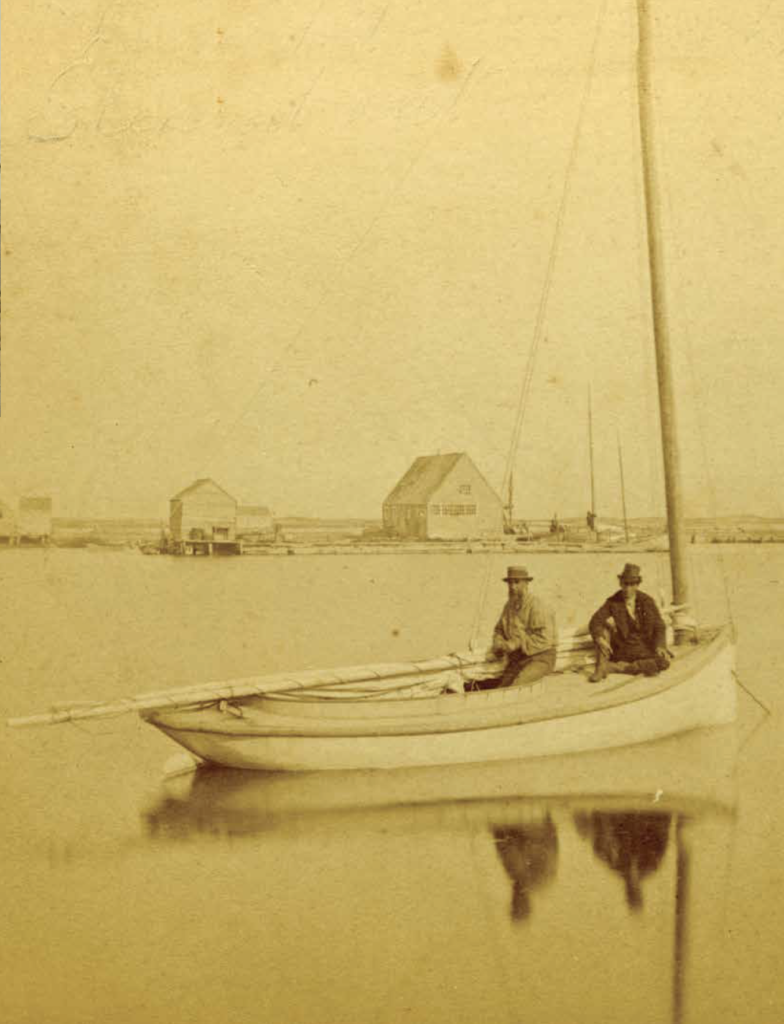
NHA COLLECTIONS SG14618
Pleasure boating was well established as a feature of the Nantucket summer scene long before the Nantucket Yacht Club was founded in 1906. Immediately the club organized races where the members could pit their catboats, knockabouts, and other recreational craft against each other. Because different boats have different performance characteristics, a system of handicapping was used for certain races to make the competition fairer, and boats of similar rigs or designs were raced only against each other. Before long, the yacht club, like many other clubs across the country, sought to encourage members to invest in boats all built to the same design, to make racing fairer and eliminate the need for handicapping.
The first step in this direction came in 1910, when a committee of the club commissioned 25-year-old B. Karl Sharp (1884–1962) to design a 13-foot catboat for members’ use as a “one-design” racing boat. Sharp was a lifelong island summer resident and a son of Dr. Benjamin Sharp (1858–1915), a gifted zoologist and sailor who contributed extensively to the cultural life of Nantucket.
The elder Sharp instilled in his two sons a deep love of sailing, which led Karl both to a lifetime of yachting and to the study of naval architecture at MIT, from which he graduated in 1907. He founded the firm of Edwards and Sharp, naval architects and marine engineers, with E. A. Sharp soon after graduating.
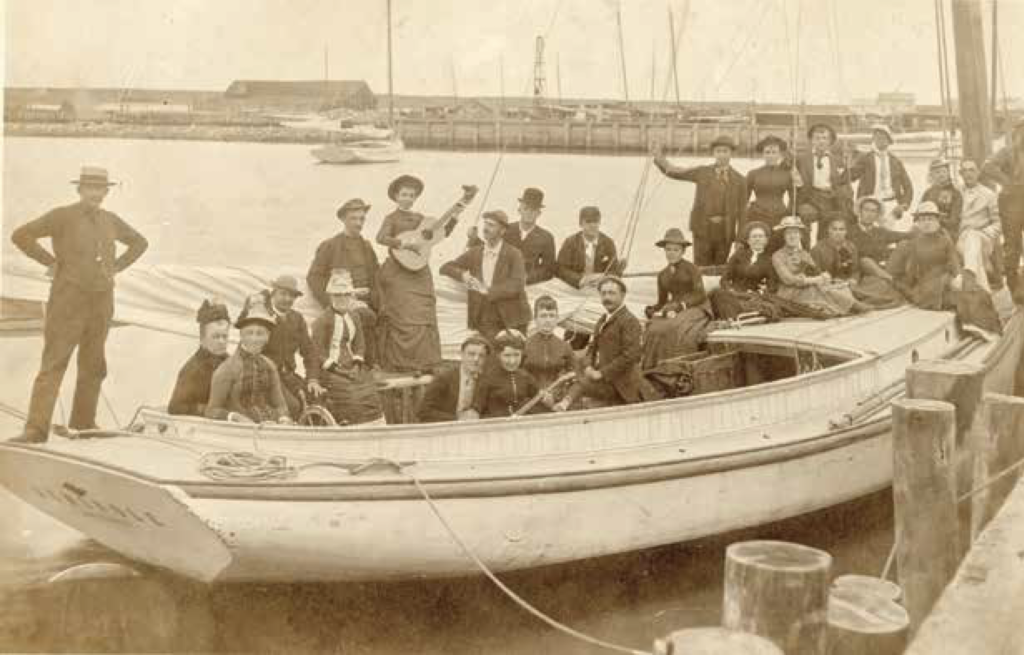
NHA COLLECTIONS P22465
Sharp’s one-design catboat was intended to be a small and affordable boat for racing. Thirteen feet long overall and 6-feet, 2-inches in beam, the design carried a 20-foot mast and 16-foot, 8-inch boom to support a 175-square-foot sail. Six members stepped forward to order copies, which the M. J. Casey Co. of New Bedford delivered to Nantucket in July 1910. The boats cost $150 each, plus $10 for Sharp’s plans and his “supervision of the builders.” The original owners were James Cunningham Bishop, F. A. Dillingham, Sidney Este, Alfred Gardiner, Lila Hedges, and Mrs. Henry O. (Jenny) Underwood.
A review of Sharp’s one-design catboat was published in the yachting magazine The Rudder in May 1916. It declared the boats “very successful,” explaining that the “boat . . . is just the thing for a club that wants a wholesome and inexpensive one-design class, or for the individual who wants a good type of small boat for the youngsters to learn in.” Indeed, summer yacht club racing reports published in the Inquirer and Mirror highlight these boats being raced by children. Teenager Louisa Dillingham raced her family’s boat Hobo many times in 1911 and 1912. Twelve-year-old Muriel Bishop raced the Merry Widow with her 18-year-old sister, Augusta, as crew, although they were frequently defeated by 12-year-old Linda Wallace in the Kewpie. The boats were also popular with women sailors, with race reports frequently mentioning Lila Hedges in the Vim, Jenny Underwood in Tinker, and Eliza Codd in Pronto.
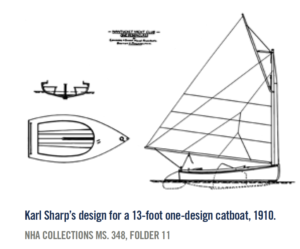
It appears that no more of these boats were built beyond the initial six; it is not clear why they did not form a lasting one-design solution for the Nantucket Yacht Club. But they did demonstrate the utility of a small catboat for youngsters to sail. Helen Wilson Sherman, who learned to sail at the club in the 1920s, recalled in a 2002 interview that “there were a lot of children floating around the yacht club,” the result of a summer culture where women and children come to the island full time and needed activities, while many husbands remained at home to work and visited for more limited periods of time. Sherman also recalled that many of the boats club members sailed were too big for children to handle. In 1921, the club made a second attempt to create a one-design fleet of small catboats, this time expressly for young sailors to learn in and race. Vice Commodore Clarence Gennett led the effort, reportedly at the behest of Commodore Henry Lang. Gennett commissioned a design for a 16-foot catboat from W. D. Allen, president of the Port Jefferson Marine Railway Corporation of Port Jefferson, Long Island. Allen was a descendent of Nantucket and New Bedford whaling captains as well as a graduate of MIT. The design his firm developed for the club envisioned boats 16-feet long and 7-foot, 9-inch in beam, with 18-foot, 2-inch masts and 20-foot, 3-inch booms. The sail area was to be 230 square feet. The design was accepted by the club’s officers in November 1921, and seven members stepped forward to commission boats based on it. These were constructed at Port Jefferson in the spring of 1922 and delivered to the island in time for the summer racing season. The first seven boats were the Blue Devil, for Henry Lang; Flapper, for Clarence Gennett; G.W.G., for B. F. W. Russell; Luan, for Ann Donald; Margie, for Leeds Mitchell; Moby Dick, for Everett Crosby; and Nancy, for Henry Shaw.

It was Gennett’s idea that the boats wear sails of different colors to distinguish them, and the lively effect this created immediately led to the name “rainbow fleet.” The first seven boats had sail colors blue, light yellow, green, tan, red, deep yellow, and old rose.
The club hoped to create a fleet of at least sixteen boats. To do this, more members needed to buy into the idea and purchase boats. Gennett lined up a commitment from Ray S. Deering at the Nantucket Boat Works committed to building four or more by summer 1923 for a cost of $475 each. To press the scheme, Gennett, who was a recording company executive from Indiana, sent a phonograph record to all the members of the yacht club in January 1923 encouraging the purchase of more Rainbows. On the record, Gennett sent greetings and extolled the project:
The “rainbow fleet” should sail this summer sixteen strong. . . . We ask you as a member of the Nantucket Yacht Club to help us make the racing at the club a feature of the summer at Nantucket. This appeal to our members . . . to buy a boat is made in the spirit of Nantucket and each member is requested to join our fleet with the “rainbow” sails and race with us on the afternoons of Independence Day, Labor Day, and each Saturday during the season.
Do it now! . . . Ask the owner of a “rainbow” boat how they sail and if they are not safe for children and grown-ups. They are loads of fun, fresh air, and salt water. Join us now. Do not put it off. Act today.
Gennett’s special appeal was only mildly successful, resulting in orders for just three additional boats. There became the Dede, for H. W. Davis; Surge, for Joseph Metcalf; and Wolverine, for A. E. Smith; with sail colors of orange, light blue, and coffee brown, respectively.
The Rainbow fleet raced each other many times during the summer of 1923 and attracted frequent comment in the newspaper, “the usual race of the ‘rainbow fleet’ was a picturesque as ever,” the “Yacht Club Notes” columnist reported in early August, “the varied colored sails making a most beautiful picture. The fleet, ten in all, jockeyed at the starting line . . . . The winner was the Surge.” The next month, The “Water Front” columnist wrote, “The Yacht Club’s ‘rainbow fleet’ with their manycolored sails made a pretty picture in the race on Labor Day . . . . Many persons gathered on the wharves and on the point to watch the progress of the race.”
Despite the popular visual interest the fleet immediately created, the ten original Rainbow catboats proved to have sailing and maintenance difficulties. The Rainbows were strong boats for sailing close to the wind, but they proved to be deficient running before the wind, where careful handling was needed to prevent the bows from diving in even mild following seas. Their weather helm was very hard, difficult for a strong adult to handle and largely impossible for children. There were also construction deficiencies with the steambent ribs and the planking, requiring close attention at the start of each season.
After a few years of lackluster performance, it became clear to club leadership and the boats’ owners that the 16-foot Rainbows were not fulfilling their intended purpose. To solve this inadequacy, Captain Charles S. Collins ordered in 1927 a flight of smaller and lighter 12-foot catboats from the Beetle Company of New Bedford. These were so called “Beetle Cats,” a design developed by the Beetle shop in 1921 that was already popular all along the southern New England coast and was demonstrably easy for children to handle.
For the 1927 season, the older Rainbows continued to race, while the new “Little Rainbows” formed a class of their own sailed entirely by children. A racing report from July 1927 notes, “The Little Rainbow Fleet has proved itself a fine class and everyone is proud and happy. Master Cutler won on Wednesday, sailing a fine race and the whole fleet congratulates him. Miss Smith had hard luck with her tiller. Miss Gennett and her brother made a gallant fight but succeeded in coming in second. Miss Helen Wilson won an easy third and hasn’t go over the thrill yet. The poor old Rear Commodore hit a shoal and never came in at all.”
Both classes continued in 1928, but the end was in sight for the original Rainbows. “In the R Class, the old rainbow class,” the newspaper reported in early July 1928, “only one boat went over the course, which was the Flapper, sailed by Clarence Gennett.” In the N or Little Rainbow Class, multiple boats enthusiastically raced. By 1929, there were at least twenty three Little Rainbows racing for the club, while there were no longer enough old Rainbows to race in their own separate class. By 1931, most of the old Rainbows had been sold off and the Rainbow Fleet, now made up entirely of 12-foot Beetle Cats, numbered sixty strong.
Helen Wilson Sherman, one of the first Little Rainbow sailors in 1927 and the second commodore of the Little Rainbow Association, remembered that it was her uncle, the playwright Austin Strong, who introduced the Beetle Cat to the Nantucket Yacht Club. In later years, Strong himself took credit for starting the Rainbow Fleet, which is an exaggeration. But it is not an exaggeration that he took a special interest in youth education and sail training during his two years as club commodore in 1930–31, and the Rainbow Fleet flourished under his leadership and that of yachtsman William W. Swan, the well-known racer Strong brought to Nantucket in 1930 to teach the club youngsters. It was Swan in 1930 who instituted the rule that only juniors under seventeen years of age could race in the Little Rainbow Class.
It took only a few years for the colored sails of the Rainbows, both big and little, to become part of the image of Nantucket. “See Gardiner’s pictures of the Rainbow Fleet,” newspaper ads suggested in 1929, referring to the souvenir views and postcards which photographer H. Marshall Gardiner specialized in producing for sale to island visitors. His iconic view of the Rainbow Fleet outward bound around Brant Point is one of the defining images of the island in the twentieth century.
“The [yacht club] Racing Committee has a very warm feeling for the Little Rainbow Class,” the newspaper declared in 1930. “They consider that it is the most important class in the fleet, for it not only brought fame to the Club, but is has made a reputation on account of turning out so many fine young sportsmen and sportswomen.”

